Basics of Design
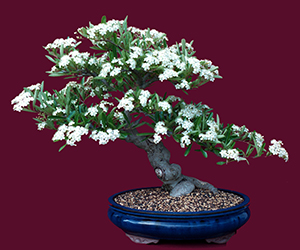
Slant Style (Shakan)
by Lew Buller
This firethorn (pyracantha) is my favorite slant style.
The Editor of Bonsai, Journal of the American Bonsai Society liked it as well. He made it on the cover photo of Spring 2003, Volume 37, Number 1. The only special design requirement it has it that it needs extra room between branches to let both blooms and berries grow.
The tree did not start out in life as a slant style. It was a low branch on a six foot tall leader. Not much to do with a tall, vertical tree with little or no taper, so I cut the leader off and made the low side branch into a bonsai. There’s the beginning of a lesson here. Don’t assume you have to use a tree in the form in which you found it.
(l to r) Olive in Slant style; Olive as Informal Upright
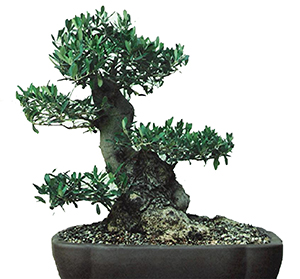
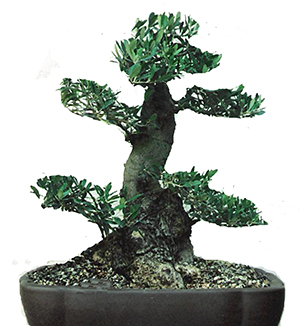
I paid $26 for a 9 foot tall olive in a 24-inch growing box that started off with a strong bend to the left and only turned vertical when it hit the edge of the box. It wasn’t heavy; years of watering had washed most of the soil off. It was tall, though. Too tall to go in my truck. After I paid for it, I proceeded to cut the olive down to about the same height as the edge of the box. I took it home, reduced the root mass over a couple of years, and potted it in a bonsai pot.
I sold it for $250–the pot was expensive–to a bonsai enthusiast who said the tree should be upright and not slanting. Computer software enabled a 250 clockwise turn so you can see what the buyer had in mind.
What is the dividing line between slant style and informal upright? The apices of both informal upright and formal upright should be directly over the root ball when seen from the front. The formal upright reaches that position by going in a straight line; the informal upright curves left or right or perhaps both before reaching the apex. If the tree leans out away from the root ball and does not come back to center, it is a slant style.
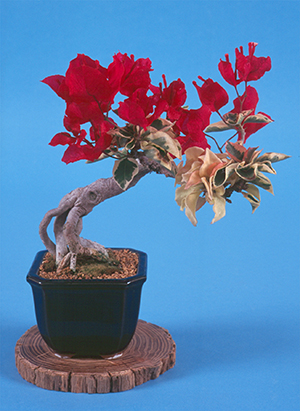
This little 10 inch slant style bougainvillea has two names, Raspberry Ice and Hawaii.
The color of the bracts tells you why it is called Raspberry Ice. The bracts surround tiny white tubular true flowers; the colorful bracts attract the pollinators. Hummingbirds will check them our in our back yard, but either their tongues are not long enough or the nectar is not attractive as the birds never attempt to sample it.
The Hawaii is the only variegated bougainvillea I know. Don’t know how it got its name, but it’s a beautiful plant. I planted two in our backyard, but they are more shrub than climbers and have a hard time competing with the others we have there.
There’s no way this small Kishu (left image) can be considered anything other than a slant style, even if some of the foliage on the right side does come back over the root base.
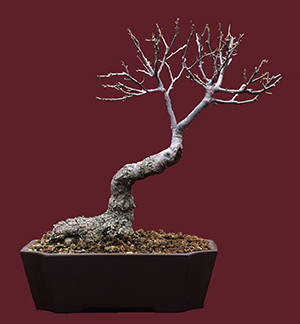
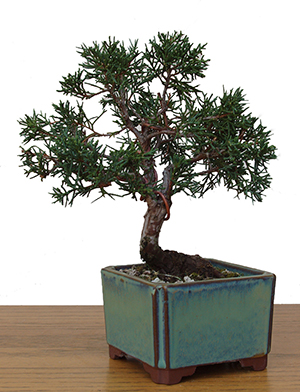
The same is true for the cork oak (Quercus suber) on the right. It was not trained in this shape; it grew this way, except that one lower branch was removed. It is just beginning to open buds, the best time for transplanting. In Mediterranean countries, the cork oak grows much larger and every nine years the outer layer of cork is removed to be cut into the corks used in wine and other bottles.
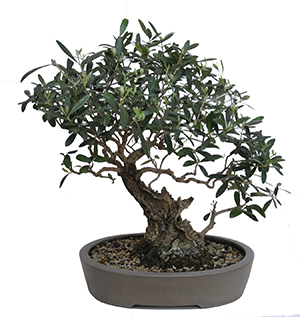
The slant style olive was transplanted about six weeks ago and the process is described elsewhere.
It is included again because it has begun to throw new growth (the light yellow tips) and the dead brown leaves are gone. It is not yet healthy enough to be wired, so the design is a little rough, but it will be wired in the fall of 2014.
It has been developed mostly through clip-and-grow, but the curved branches tell you some wire has been used earlier. Generally I don’t like peeled bark trees, but this one fairly demanded it.
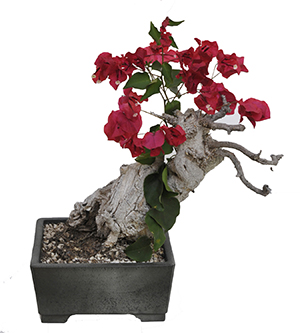
I am introducing you to tanuki.
Tanuki is not a style, but rather a technique that can be applied to several styles of trees. It consists of adding live new growth to a dead tree and I will illustrate the process in the Techniques Series. In this instance, I am applying the technique to an old bougainvillea stump. The stump is nearly 20 years old and was on the decline at the time I bought it. It did not have roots all the way around the base and the dead space gradually expanded until the entire tree died. (John Naka liked to say “The tree didn’t die; you killed it.”)
Lime sulfur is often recommended for stopping decay on bare wood. Used here, it would look as if the trunk had been white-washed. Better to use wood hardener first, and then apply lime sulfur later. If the result is still too white, add some India ink to the lime sulfur to get grayish tones.
We (Eitan, the Apprentice and I) decided to turn one of my old torulosas into a slant style. I have been growing them for at least 15 years, with no distinct style in mind, rather just following what the tree wanted to do. In pots, torulosas can develop two kinds of foliage: an erect, strong-growing leader that results eventually in a deep green foliage with branches tapering to a fine point, the same as it would be if grown in the ground. The other style is down-hanging and weak, The tree we worked on had the latter kind of foliage. I had retained the down-hanging weak foliage as a way of slowing down the growth of the tree.
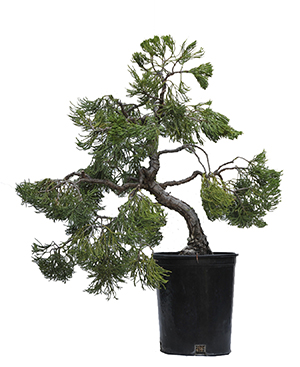
Things to do: Lower the apex.
Balance the foliage on the left and right side of the tree. Consider not having any foliage hanging down below the rim of the pot. Bend the middle part of the trunk even more to the left. Let it grow.
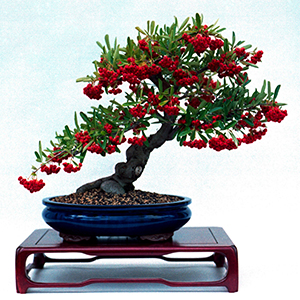
This pyracantha in its spring finery welcomed you to slant style bonsai.
In its Holiday finery, it says “Happy Holidays” and “Goodbye.”
